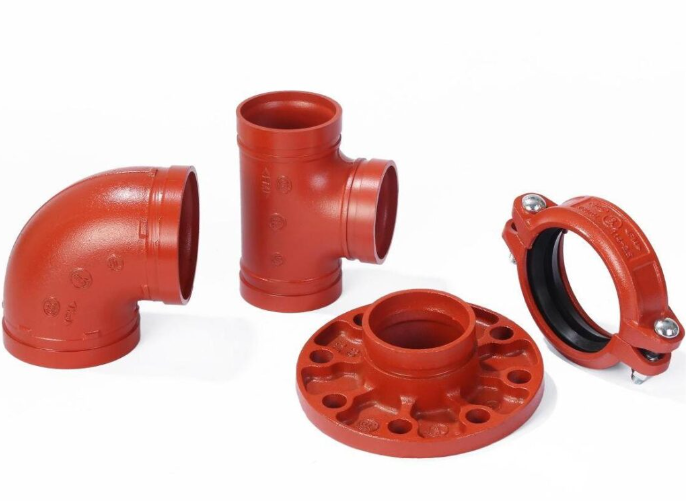Case Study: Reducing Downtime with Grooved Pipe Installation in a Manufacturing Plant
Jul. 22, 2025
Introduction
In the fast-paced manufacturing industry, downtime is the enemy of productivity. Whether caused by system upgrades, maintenance, or unexpected failures, even a few hours of halted operations can translate to significant revenue loss. Across the Middle East, where industrial output continues to rise—especially in countries like Saudi Arabia, the UAE, and Qatar—the demand for efficient, scalable piping solutions is higher than ever.
In this case study, we explore how one large-scale plastics manufacturing facility in the UAE slashed its installation time and minimized operational disruptions by switching from traditional welded piping systems to grooved pipe fittings. The transition not only reduced downtime by over 60%, but also enhanced system flexibility and long-term maintenance efficiency.
Regional Context: Industrial Growth in the Middle East
According to a 2024 report by MEED, the Gulf Cooperation Council (GCC) manufacturing sector is set to reach $150 billion USD in output by 2030, with infrastructure and industrial plants at the forefront of this growth. In particular:
UAE aims to double the size of its industrial sector by 2031 through its "Operation 300bn" strategy.
Saudi Arabia's Vision 2030 includes plans to develop 36 new industrial cities.
Qatar and Oman have invested heavily in energy and materials production.
Amid this rapid expansion, modular, efficient piping systems are in high demand, especially for HVAC, chilled water loops, fire protection, and process fluid transport.
The Problem: Downtime from Welding and Maintenance
The manufacturing plant in question, located in Sharjah, UAE, was undergoing an expansion to add two new production lines and retrofit its existing cooling water and fire suppression systems. The engineering team initially considered continuing with traditional welded piping systems, which had been the standard for decades.
However, after a risk assessment, several challenges became apparent:
Long installation times due to precision welding and inspection protocols.
Significant fire risks associated with hot works in enclosed factory zones.
Extended shutdown periods—each production line could be offline for up to 7–10 days.
Limited flexibility for future changes or re-routing of pipelines.
As such, the team decided to explore grooved pipe solutions as an alternative.

The Solution: Switching to Grooved Pipe Fittings
Grooved piping systems use a mechanical method to join pipes by rolling a groove into the pipe ends and connecting them with a gasketed coupling. Unlike welded systems, no hot works or curing time are required, allowing for rapid, clean installations.
The plant partnered with a local engineering contractor experienced in grooved pipe installation using DIKAI-certified components, covering:
Chilled Water System: DN100–DN300 carbon steel pipes
Fire Protection Network: Red-painted DN80–DN250 pipes
Compressed Air Lines: Stainless steel grooved systems
The fittings used included grooved couplings, elbows, tees, reducers, flanges, and flexible couplings for vibration absorption.
Results: Downtime Reduction and Performance Gains
Key Outcomes:
Installation time cut by 63%: From 10 days (welded) to 3.5 days (grooved)
Zero hot work incidents reported during installation
Operational downtime reduced from 7 to 2 days
Easier access for future maintenance due to mechanical joints
Leak-free pressure testing results within 48 hours of installation
Moreover, labor costs were reduced by over 30%, as the system required fewer skilled welders and less post-installation inspection.
Industry Feedback
The plant’s Facilities Manager noted:
“With grooved piping, we not only avoided long production interruptions but also ensured a safer, cleaner installation environment. It gave us the flexibility to grow without completely redesigning our backbone infrastructure.”
An independent audit six months later found that the system had zero recorded leaks and had already saved an estimated 1,200 man-hours in combined installation and maintenance labor.
Why Grooved Fittings are Gaining Ground in the Middle East
The successful outcome of this project reflects a broader regional trend. Grooved pipe fittings are increasingly adopted in Middle East industrial zones for the following reasons:
Speed of assembly fits the region’s rapid development pace
Compliance with international fire safety codes (NFPA, UL/FM)
Compatibility with seismic bracing systems, essential in new industrial cities
Lower total cost of ownership due to reduced maintenance and downtime
Considerations When Choosing Grooved Fittings
Before switching to grooved piping, industrial buyers should assess:
Pipe material compatibility: Grooved fittings are available for carbon steel, stainless steel, and copper.
Pressure rating and temperature range: Ensure the fittings match the application’s technical requirements.
Certifications: Always choose fittings with FM, UL, or LPCB approvals for critical systems.
Installation training: Partner with providers who offer on-site or online installation training for your staff.
Conclusion
The shift from welded to grooved pipe systems is more than a technical upgrade—it’s a strategic move toward operational agility, safety, and long-term savings. In fast-developing regions like the Middle East, where every day of downtime can mean massive losses, grooved pipe fittings are proving essential to staying competitive.
DIKAI, a trusted manufacturer of grooved piping systems, is committed to delivering certified, reliable, and scalable solutions for global clients in industrial, commercial, and municipal sectors. Whether you're upgrading HVAC, expanding your fire suppression system, or modernizing a process line—choose DIKAI grooved fittings to build faster, safer, and smarter.
Oct. 22, 2025
Rigid Coupling vs Flexible Coupling: Understanding the Differences and ApplicationsOct. 22, 2025
Steel vs Aluminum Rigid Coupling: Strength and Weight AnalysisSep. 24, 2025
New NFPA / UL / International Standards for Fire Pipe Couplings — 2025–2026 Technical Brief




